Intel 3rd Gen Xeon Scalable (Ice Lake SP) Review: Generationally Big, Competitively Small
by Andrei Frumusanu on April 6, 2021 11:00 AM EST- Posted in
- Servers
- CPUs
- Intel
- Xeon
- Enterprise
- Xeon Scalable
- Ice Lake-SP
SPECjbb MultiJVM - Java Performance
Moving on from SPECCPU, we shift over to SPECjbb2015. SPECjbb is a from ground-up developed benchmark that aims to cover both Java performance and server-like workloads, from the SPEC website:
“The SPECjbb2015 benchmark is based on the usage model of a worldwide supermarket company with an IT infrastructure that handles a mix of point-of-sale requests, online purchases, and data-mining operations. It exercises Java 7 and higher features, using the latest data formats (XML), communication using compression, and secure messaging.
Performance metrics are provided for both pure throughput and critical throughput under service-level agreements (SLAs), with response times ranging from 10 to 100 milliseconds.”
The important thing to note here is that the workload is of a transactional nature that mostly works on the data-plane, between different Java virtual machines, and thus threads.
We’re using the MultiJVM test method where as all the benchmark components, meaning controller, server and client virtual machines are running on the same physical machine.
The JVM runtime we’re using is OpenJDK 15 on both x86 and Arm platforms, although not exactly the same sub-version, but closest we could get:
EPYC & Xeon systems:
openjdk 15 2020-09-15
OpenJDK Runtime Environment (build 15+36-Ubuntu-1)
OpenJDK 64-Bit Server VM (build 15+36-Ubuntu-1, mixed mode, sharing)
Altra system:
openjdk 15.0.1 2020-10-20
OpenJDK Runtime Environment 20.9 (build 15.0.1+9)
OpenJDK 64-Bit Server VM 20.9 (build 15.0.1+9, mixed mode, sharing)
Furthermore, we’re configuring SPECjbb’s runtime settings with the following configurables:
SPEC_OPTS_C="-Dspecjbb.group.count=$GROUP_COUNT -Dspecjbb.txi.pergroup.count=$TI_JVM_COUNT -Dspecjbb.forkjoin.workers=N -Dspecjbb.forkjoin.workers.Tier1=N -Dspecjbb.forkjoin.workers.Tier2=1 -Dspecjbb.forkjoin.workers.Tier3=16"
Where N=160 for 2S Altra test runs, N=80 for 1S Altra test runs, N=112 for 2S Xeon 8280, N=56 for 1S Xeon 8280, and N=128 for 2S and 1S on the EPYC system. The 75F3 system had the worker count reduced to 64 and 32 for 2S/1S runs.
The Xeon 8380 was running at N=140 for 2S Xeon 8380 and N=70 for 1S - the benchmark had been erroring out at higher thread counts.
In terms of JVM options, we’re limiting ourselves to bare-bone options to keep things simple and straightforward:
EPYC & Altra systems:
JAVA_OPTS_C="-server -Xms2g -Xmx2g -Xmn1536m -XX:+UseParallelGC "
JAVA_OPTS_TI="-server -Xms2g -Xmx2g -Xmn1536m -XX:+UseParallelGC"
JAVA_OPTS_BE="-server -Xms48g -Xmx48g -Xmn42g -XX:+UseParallelGC -XX:+AlwaysPreTouch"
Xeon Cascade Lake systems:
JAVA_OPTS_C="-server -Xms2g -Xmx2g -Xmn1536m -XX:+UseParallelGC"
JAVA_OPTS_TI="-server -Xms2g -Xmx2g -Xmn1536m -XX:+UseParallelGC"
JAVA_OPTS_BE="-server -Xms172g -Xmx172g -Xmn156g -XX:+UseParallelGC -XX:+AlwaysPreTouch"
Xeon Ice Lake systems (SNC1):
JAVA_OPTS_C="-server -Xms2g -Xmx2g -Xmn1536m -XX:+UseParallelGC"
JAVA_OPTS_TI="-server -Xms2g -Xmx2g -Xmn1536m -XX:+UseParallelGC"
JAVA_OPTS_BE="-server -Xms192g -Xmx192g -Xmn168g -XX:+UseParallelGC -XX:+AlwaysPreTouch"
Xeon Ice Lake systems (SNC2):
JAVA_OPTS_C="-server -Xms2g -Xmx2g -Xmn1536m -XX:+UseParallelGC"
JAVA_OPTS_TI="-server -Xms2g -Xmx2g -Xmn1536m -XX:+UseParallelGC"
JAVA_OPTS_BE="-server -Xms96g -Xmx96g -Xmn84g -XX:+UseParallelGC -XX:+AlwaysPreTouch"
The reason the Xeon CLX system is running a larger back-end heap is because we’re running a single NUMA node per socket, while for the Altra and EPYC we’re running four NUMA nodes per socket for maximised throughput, meaning for the 2S figures we have 8 backends running for the Altra and EPYC and 2 for the Xeon, and naturally half of those numbers for the 1S benchmarks.
For the Ice Lake system, I ran both SNC1 (one NUMA node) as SNC2 (two nodes), with the corresponding scaling in the back-end memory allocation.
The back-ends and transaction injectors are affinitised to their local NUMA node with numactl –cpunodebind and –membind, while the controller is called with –interleave=all.
The max-jOPS and critical-jOPS result figures are defined as follows:
"The max-jOPS is the last successful injection rate before the first failing injection rate where the reattempt also fails. For example, if during the RT-curve phase the injection rate of 80000 passes, but the next injection rate of 90000 fails on two successive attempts, then the max-jOPS would be 80000."
"The overall critical-jOPS is computed by taking the geomean of the individual critical-jOPS computed at these five SLA points, namely:
• Critical-jOPSoverall = Geo-mean of (critical-jOPS@ 10ms, 25ms, 50ms, 75ms and 100ms response time SLAs)
During the RT curve building phase the Transaction Injector measures the 99th percentile response times at each step level for all the requests (see section 9) that are considered in the metrics computations. It then computes the Critical-jOPS for each of the above five SLA points using the following formula:
(first * nOver + last * nUnder) / (nOver + nUnder) "
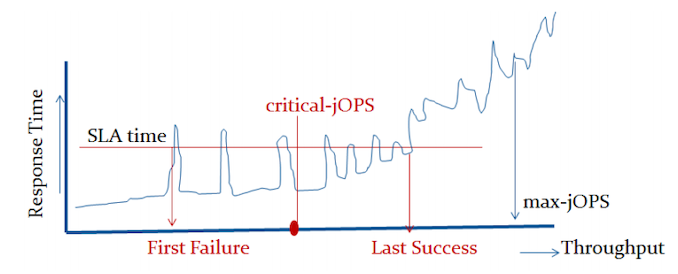
That’s a lot of technicalities to explain an admittedly complex benchmark, but the gist of it is that max-jOPS represents the maximum transaction throughput of a system until further requests fail, and critical-jOPS is an aggregate geomean transaction throughput within several levels of guaranteed response times, essentially different levels of quality of service.
Beyond the result figures, the benchmark keeps detailed track of timings of responses and tracks a few important statistical data-points across a response-time curve, as follows:
Comparing the Xeon 8380 to the Xeon 8280, what’s to be immediately noted is the much-improved maximum throughput figure of the new part, scaling at +64% compared to its predecessor. We’re seeing that the load slope where the 99th percentile SLA figures rises comes in at a relative earlier point, and the corresponding critical-jOPS point lands in relatively earlier than the Xeon 8280.
I included the AMD EPYC 7763 and Altra graphs for context.
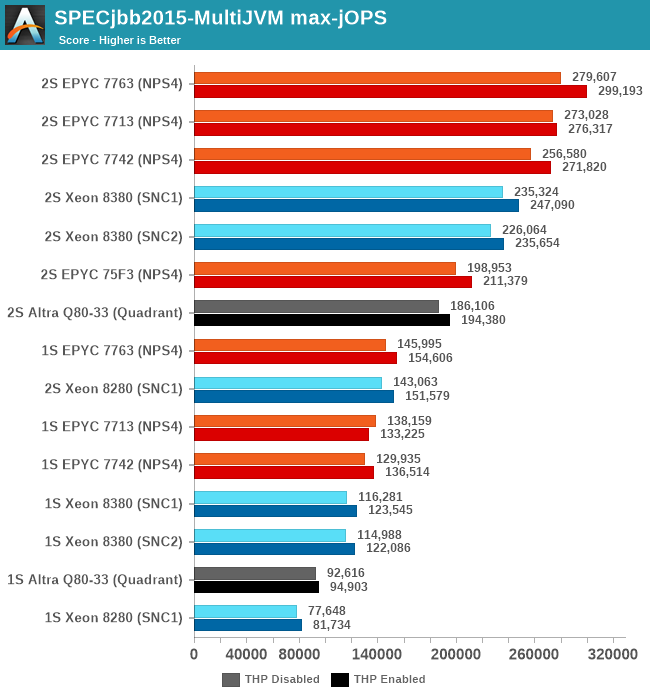
My theory here is that because of the good per-core performance of the Intel design, along with the monolithic mesh architecture, while Intel doesn’t quite catch up with AMD, it performs very well with relatively significantly fewer cores.
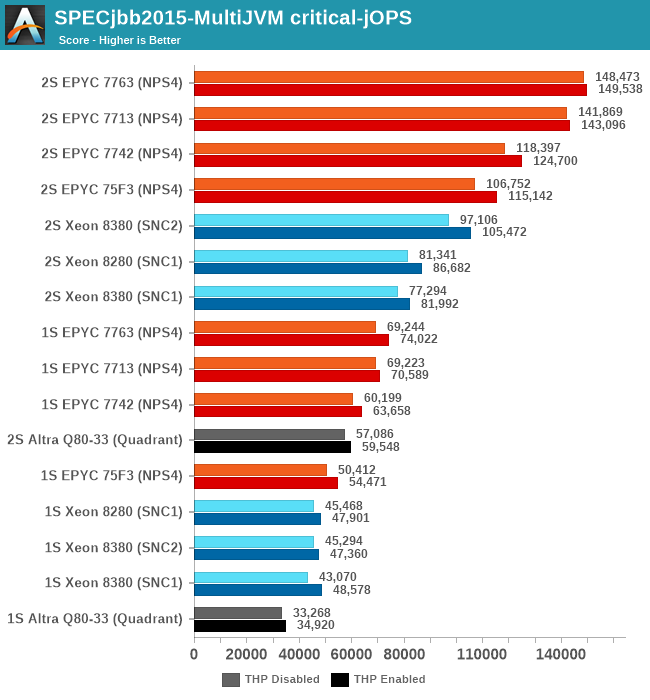
What’s really odd about the results though is that this larger increase only happens in the 2S test figures, with the 1S being unfavourable to the new Ice Lake part, losing to the 8280 in both modes. I had repeated these numbers several times to be sure they’re repeatable, and they were indeed so – as odd as that is. The 1S reduction in the critical-jOPS could be explained through the larger mesh size and larger core count of the 8380, and we did see slight regressions in core-to-core latencies. If the mesh intersection bandwidth did not increase with its size, that also could be a culprit of these figures, as the workload is hammering core-to-core transactions as well as the L3 cache of the chip.
Why the 2S figures see a bigger advantage of migrating to SNC2 could be a result of how on-chip traffic is routed, as well as the traffic flows through the UPI link blocks of the chip – at least that would be my working hypothesis.
Intel had disclosed a +62% figure for a “Java Throughput under SLA” workload they wouldn’t specify, and this does track well with our max-jOPS results. While the critical-jOPS increases seem a bit disappointing generationally, how it translates to the real world in contrast to the max-jOPS figure depends on how strict one’s SLA metrics are.


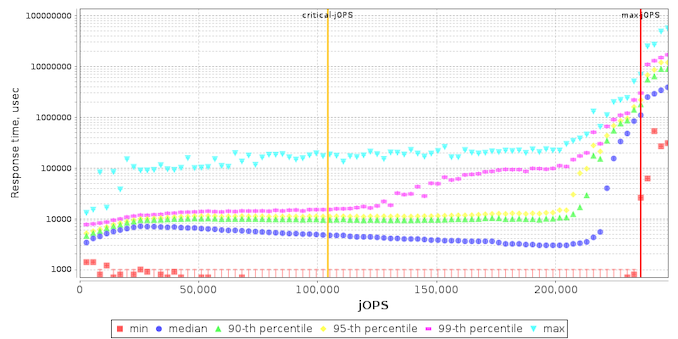
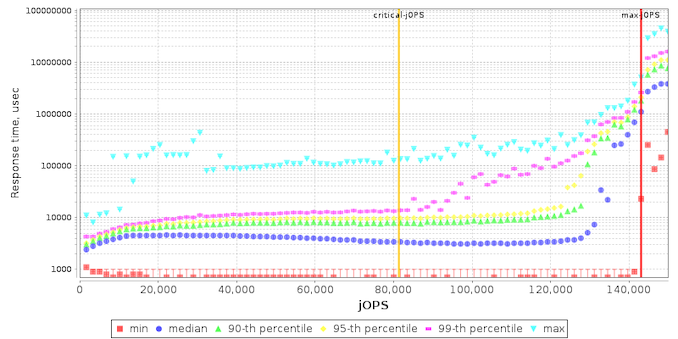
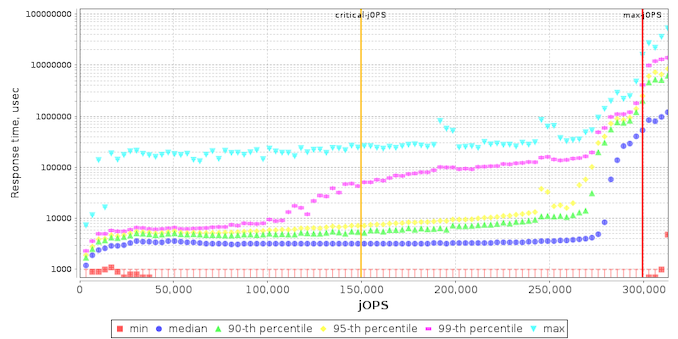
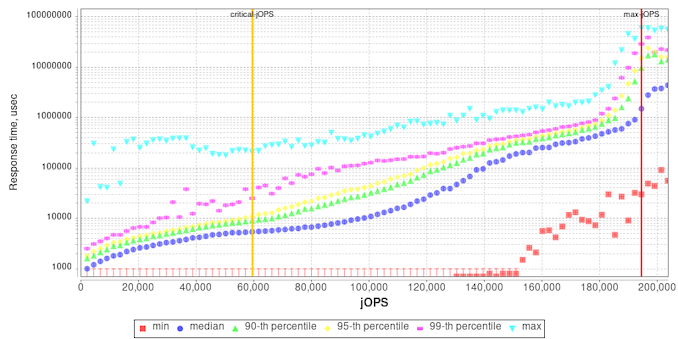








169 Comments
View All Comments
mode_13h - Monday, April 12, 2021 - link
With regard specifically to testing AVX-512, perhaps the best method is to include results both with and without it. This serves the dual-role of informing customers of the likely performance for software compiled with more typical options, as well as showing how much further performance is to be gained by using an AVX-512 optimized build.KurtL - Wednesday, April 7, 2021 - link
GCC the industry standard in real world? Maybe in that part of the world where you live, but not everywhere. It is only true in a part of the world. HPC centres have relied on icc for ages for much of the performance-critical code, though GCC is slowly catching up, at least for C and C++ but not at all for Fortran, an important language in HPC (I just read it made it back in the top-20 of most used languages after falling back to position 34 a year or so ago). In embedded systems and the non-x86-world in general, LLVM derived compilers have long been the norm. Commercial compiler vendors and CPU manufacturers are all moving to LLVM-based compilers or have been there for years already.Wilco1 - Wednesday, April 7, 2021 - link
Yes GCC is the industry standard for Linux. That's a simple fact, not something you can dispute.In HPC people are willing to use various compilers to get best performance, so it's certainly not purely ICC. And HPC isn't exclusively Intel or x86 based either. LLVM is increasing in popularity in the wider industry but it still needs to catch up to GCC in performance.
mode_13h - Wednesday, April 7, 2021 - link
GCC is the only supported compiler for building the Linux kernel, although Google is working hard to make it build with LLVM. They seem to believe it's better for security.From the benchmarks that Phoronix routinely publishes, each has its strengths and weaknesses. I think neither is a clear winner.
Wilco1 - Thursday, April 8, 2021 - link
Plus almost all distros use GCC - there is only one I know that uses LLVM. LLVM is slowly gaining popularity though.They are fairly close for general code, however recent GCC versions significantly improved vectorization, and that helps SPEC.
Wilco1 - Tuesday, April 6, 2021 - link
ICC and AMD's AOCC are SPEC trick compilers. Neither is used much in the real world since for real code they are typically slower than GCC or LLVM.Btw are you equally happy if I propose to use a compiler which replaces critical inner loops of the benchmarks with hand-optimized assembler code? It would be foolish not to take advantage of the extra performance you get only on those benchmarks...
ricebunny - Tuesday, April 6, 2021 - link
They are not SPEC tricks. You can use these compilers for any compliant C++ code that you have. In the last 10 years, the only time I didn’t use icc with Intel chips was on systems where I had no control over the sw ecosystem.Wilco1 - Tuesday, April 6, 2021 - link
They only exist because of SPEC. The latest ICC is now based on LLVM since it was falling further behind on typical code.ricebunny - Tuesday, April 6, 2021 - link
From my experience icc consistently produced better vectorized code.Anandtech again didn’t publicize the compiler flags they used to build the benchmark code. By default, gcc will not generate avx512 optimized code.
Wilco1 - Tuesday, April 6, 2021 - link
Maybe compared to old GCC/LLVM versions, but things have changed. There is now little difference between ICC and GCC when running SPEC in terms of vectorized performance. Note the amount of code that can benefit from AVX-512 is absolutely tiny, and the speedups in the real world are smaller than expected (see eg. SIMDJson results with hand-optimized AVX-512).And please read the article - the setup is clearly explained in every review: "We compile the binaries with GCC 10.2 on their respective platforms, with simple -Ofast optimisation flags and relevant architecture and machine tuning flags (-march/-mtune=Neoverse-n1 ; -march/-mtune=skylake-avx512 ; -march/-mtune=znver2 (for Zen3 as well due to GCC 10.2 not having znver3). "